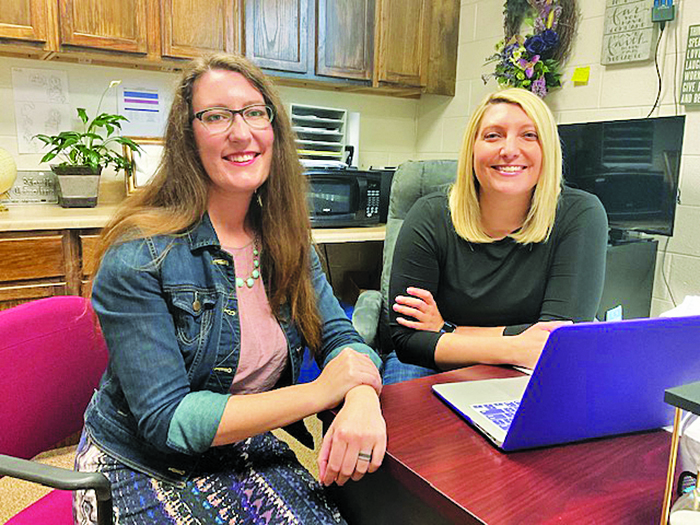Juvenile Mediator and District Court Mediator Lindsey Allen, left, works with Mitchell County Schools leaders like Bowman Middle Principal Amber Young, right.
Fred Rogers, the man known to generations as Mr. Rogers of Mister Rogers’ Neighborhood, famously said, “When I was a boy and I would see scary things in the news, my mother would say to me, ‘Look for the helpers. You will always find people who are helping.’”
Who are the helpers in our community? Where can we find them? How can we each be a helper in our own way?
Anyone who dropped by the school that morning might have wondered why Lindsey Allen was sitting on the ground next to a car with an open door in 35-degree weather.
There was an anxious child inside that car.
Lindsey wanted to find out what was wrong and how the adults inside the school could help. She is a juvenile mediator with the Mediation and Restorative Justice Center.
“I truly believe I never could have become a mediator without being a mom,” she said. “Loving someone that much allows you to see the other side. You bring that to the table.”
The child in the car had not been coming to school. In North Carolina, there was a time when parents of a child who missed 10 or more days of school could routinely be charged with a misdemeanor under the state’s truancy laws, but today schools and the justice system are more likely to work with a family as a team to figure out what’s keeping the child out of school and all work together on a solution.
That’s where Allen can come in.
“The referral was for attendance. The school folks had no idea why she was not there, but the family was supportive and cooperative so I got the referral,” Allen said. “But now they were all there and the child didn’t want to get out of the car, something that had happened many times before.”
So Lindsey asked the principal and parents, “can I try?”
“I told her I was really, really sorry for whatever was going on and that I needed her to communicate,” Allen said.
After an hour, she started to open up.
“She seemed anxious,” Allen continued. “She was having these overwhelming emotions every day.”
It became apparent to the adults that not coming to school was not a choice this child was making. She needed help.
“We were able to get her the supports and responses she needed,” Allen said. “If I can help everyone identify some
empathy and compassion with the situation we can work together to find the root issues of the conflict that brought us together. That’s when we’re able to address not only the immediate issue but talk about what got us here.
Allen said there always has to be a focus on the future.
“Focusing on the future allows us to really address restorative justice,” she said. “Restorative justice is about moving forward. This way of doing things is a way of living, not just something I do during working hours.”
In addition to her work as a juvenile mediator, she is available to the district attorneys and judges in our district court.
“The job of the DA and the judges in our system of justice is to uphold the law,” Allen said. “A diversion to mediation is one of the tools they have to do that. It’s an opportunity for them and for the community. We have the same goals. When the issues are criminal they go to court, but when the issues that bring people to the justice system are relational issues, mediation is an option.”
An example is when a young man took his grandmother’s car without permission and wrecked it. Insurance paid for the damage and Lindsey was called to mediate what was legally larceny.
“He entered a room full of support. We all knew he could do better,” Allen said. “We told him he could do better. That young man learned a lot about respect, how to move forward and how to heal his relationships with his family. It has to be fair. Victims get to articulate exactly what they need moving forward. Mediation gives families and victims a say in the outcome.”
When the offender is a juvenile, Sentencing Circles may be an option. It’s a community-minded juvenile diversion program to help students repair the harm they have done to themselves, others and the community at large.
Trained community volunteers and student peers come together with the young person to help them proactively address and make amends for a harmful incident or a behavioral concern. The Division of Juvenile Justice in the NC Department of Public Safety or Mitchell County Schools can refer students to sentencing circles.
In Mitchell County, Juvenile Mediation and Sentencing Circles are funded by NCDPS and the Mitchell County Juvenile Crime Prevention Council.
Allen is a native North Carolinian who found her home in the mountains.
“I love the mountains,” Allen said. “I can breathe better here. This is home.”
The children of Mitchell County and their families can always use more helpers. To find out more about the helpers at the Mediation and Restorative Justice Center, to volunteer or to use their services, contact Allen at 528-2778 or lindsey.mrjc@gmail.com. Visit mrjc.us for more info.

